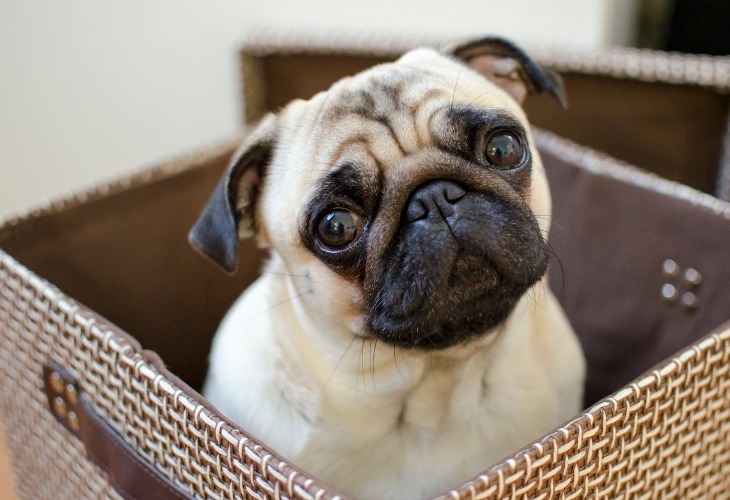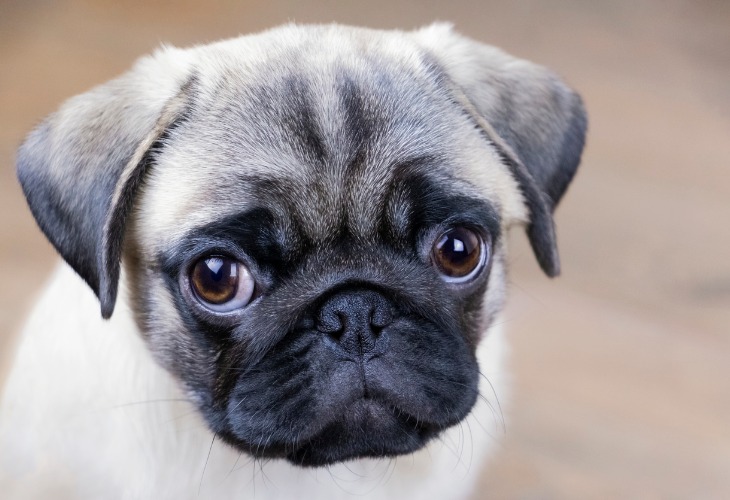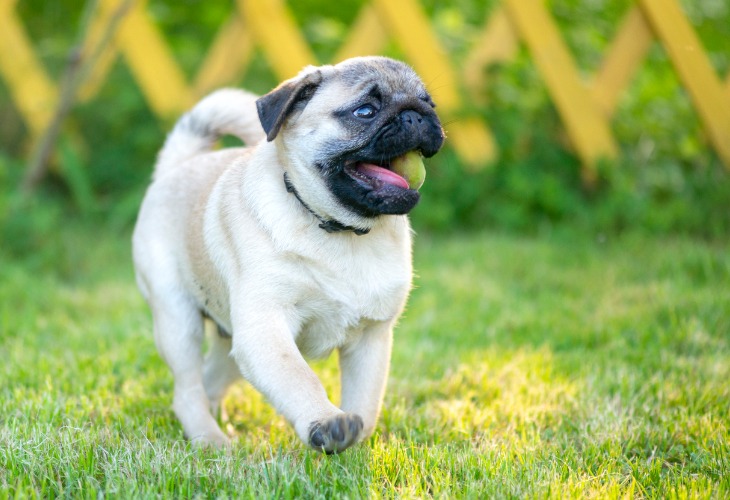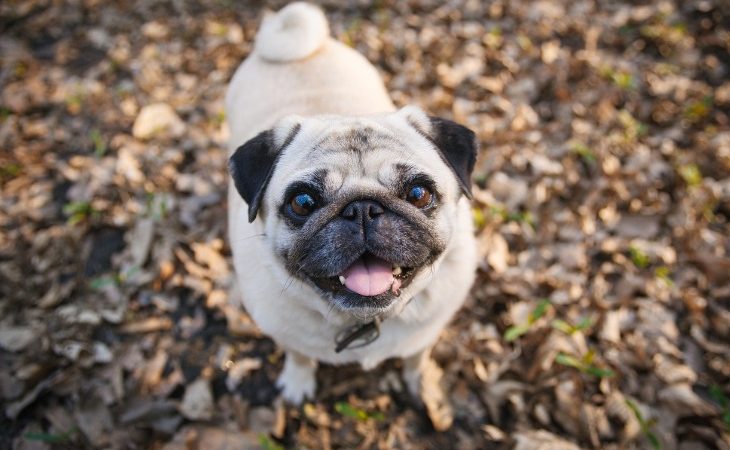Breed standard: AKC, TKC, UKC, FCI I Size: Small I Average lifespan: 12+ years I Temperament: Happy and affectionate I Coat length: Short I Origin: China
The origins of the Pug: theories and evolution
Oriental or European?
The pug is one of the world’s most popular breeds of dog. A very old breed, it can be traced back more than 2,000 years to Chinese royalty and noblemen alike. Although the breed’s origins have been debated (some have suggested it originated from the Far East while others suggest Europe), the general acceptance today is that the Pug originates from China. The first traces of its existence would have been discovered in the town of Gullin.
Unusual theories also abound as to the Pug’s physical characteristics, and therefore origins. There are those who have suggested the Pug is, in essence, a miniature mastiff-type breed (dogs like the mastiff or the Great Dane). Others have suggested the flattened snout was created by flattening (or crushing) the frontal bones during a pup’s early weeks.
Both assertions are inaccurate. For starters, the Pug is an entirely separate breed to both the mastiff and Great Dane. Different bone structures of the skull renders this theory null and void. Concerning the Pug’s well-known flattened nose, any Pugs that had their noses intentionally squashed would only affect the individual dog in question and not alter the DNA of the breed’s skeletal structure.
Historical records show that dogs with a similar muzzle to the Pug appear to have been present in China long before the Christian era. Notes of this can be found in the writings of Confucius in 551 BC where “short-mouthed dogs” were mentioned. These dogs were treated as royalty and resided in monasteries and Chinese Imperial Palaces.
Many sources of historical information pertaining to Chinese dogs can be found in the form of illustrations. These are very stylized, being traditional works of oriental art. These illustrations mainly revolve around three breeds: the Lion Dog, the Pekingese, and the Lo-Sze. Based on these illustrations, some suggest the Pug is a descendant of the Lo-Sze, although also similar to the Pekingese but with a short and smooth coat.
In particular, the main requirement for a true Lo-Sze was its size; it had to be as small as possible. The coat was short and the skin elastic-like, able to create wrinkles easily. The classic three wrinkles on the forehead were an essential element since they represented “the mark of the prince”. This “mark” resembled the Chinese characters used for the word “prince”. The dog was compact in build with a square jaw. Some dogs had their tails docked, while others, typically curled, were allowed.
These prized dogs were kept as possessions and were bred out of sight behind the walls of sacred cities or imperial palaces. As true dogs of the Chinese aristocracy, they enjoyed a privileged lifestyle.
European beginnings
In 200 BC, trade between China and the western world was already in existence, particularly centred around silk. Fast forward to the 16th century, and trade relations opened with Portugal and Spain, in 1516 and 1575 respectively. In the 17th century, the Dutch joined the west as a trading partner with China. It is around this time that the Pug became more commonly known in the Western world.
In particular, the Dutch are well-known for their love and long history with the Pug (some go as far to say its origins start here). It is said that the Pug was first brought over from China to Holland via the Dutch East India Company.
A famous anecdote involving the Pug tells the story of a small dog who is said to have saved the life of the Prince of Orange, otherwise known as William the Silent or William the Taciturn of Holland’s Royal House of Orange.
This anecdote is said to have taken place in the 1570s when, during a surprise attack by the Spaniards against the Dutch, a small dog named Pompey barked furiously to alert the Prince of Orange of the ambush. According to the various descriptions of the dog, it has been suggested that it was indeed a Pug. However, this Pug would have looked somewhat different to the Pug we know today, as the breed evolved well afterwards. Regardless, the dog’s actions earned him great praise and led to the breed’s increased popularity in Holland where it was known as the “Dutch Mastiff”. This may explain why some believe the breed’s origins are Dutch.
Much of the spread of the Pug through Europe can be attributed to its popularity in Holland. This occurred towards the end of the 17th century, where they became particularly popular in countries such as France, Italy and parts of Germany.

From the 19th century to the present day
At the beginning of the 19th century, the Pug’s popularity took a turn downward. This was primarily due to the effects of pet trends, as well as a change in its physical characteristics. Through cross-breeding, the new-look Pug almost lost its distinct black “mask” around its face while its coat became hard and shaggy.
A new wave of Pug breeding began in the middle of the 19th century. With the advent of breed competitions and the banning of dog fights in some countries, people were becoming more interested in showing off the aesthetic beauty of their dog. Dog shows and competitions were particularly successful in the 1860s. Cheating and fake pedigrees were common until the UK’s Kennel Club, founded in 1873, began to record the pedigrees of dogs and their show victories. With this new standard and the renewed seriousness of competitions and shows, two Pug color lines began to dominate: the lighter, apricot-fawn Morrison line and the darker, stone-fawn Willoughby line.
In 1860, two Pugs named Lamb and Moss were brought from China to England. This introduced another line to the Pug family and changed the landscape of Pug breeding. Lamb and Moss gave birth to Click, who went on to breed many of the new-look Pugs that we associate today with the breed.
In 1883, the English Pug Club was founded and quickly established a standard. The black Pug was officially recognized in 1886, although it is believed this color variety existed long before that. These black Pugs would appear in litters of the normal light variety (silver or fawn) and were often eliminated very quickly.
At the end of the 19th century, the Pug’s popularity declined once again. New rivals such as the Pomeranian and Pekinese began their rise to fame, outshining the previously-admired Pug. However, in the 1960s, thanks to the Duke and Duchess of Windsor, the Pug regained its popularity throughout England. Living in exile in France, their presence across the Channel also saw the breed’s return to popularity.
Today, the Pug has once again grown in popularity thanks to the attractiveness of its personality and its trendy appeal across the Internet.
Character of the Pug
The Pug: its qualities
The Pug is a very affectionate, cuddly and playful dog. There is an endless amount of adoration that is projected from Pug to owner. In fact, they can often be clingy and will want to partake in all your activities with you. Walking therefore is a great activity you can do frequently together, even if only down to the local park or shops. They do have plenty of energy so will need to expend this, but their being extra playful will make this a joyful daily experience. A dignified and intelligent breed, you will be able to train your Pug (with plenty of patience and persistence), and they will also provide you with a cheerful demeanor in return.
Are there any downsides to having a Pug?
Pugs can be stubborn. They will require firm and persistent training from an early age, much like a Jack Russell. Being clingy, they can be protective of their owner and in turn, more reserved or even nonchalant towards strangers. Solitude is not a Pug’s friend!
Additionally, Pugs are known to suffer from breathing difficulties. This is typically associated with their flat-mouthed appearance, although recent studies suggest the shape of the skull may also play a role in the problem.
Other ailments to affect the Pug include Pug Dog Encephalitis (PDE) and canine hip dysplasia (CHD). The American Kennel Club recommends screening for the following conditions:
- Hip Evaluation
- Patella Evaluation
- Ophthalmologist Evaluation
- Pug Dog Encephalitis DNA Test

Physical characteristics of the Pug
General appearance
This is a compact and stocky dog breed that can be described as fitting neatly into a square shape. They are classified as a small dog breed, but some breeds can err towards a small medium categorization.
Zooming in on the Pug’s head
Pugs are known to have fairly large heads, however this is often in proportion to their box-like body shape. It is somewhat rounded in shape, but not overtly so. The skull has no clear indentation and the forehead wrinkles are defined without being exaggerated. The muzzle is short, flattened and square, and not upfacing. The nose is black, wide and sports large, open nostrils.
A Pug’s distinctive “puppy dog” eyes are round, large and dark and express both affection and a sense of gentleness. According to The Kennel Club’s breed standard, they should never protrude or show the whites when looking ahead nor should they be obstructed or hidden by excessive wrinkles.
With regard to the jaw, this is slightly undershot. The lower jaw is broad and the incisors form an almost straight line.
A Pug’s ears are thin, small and soft like velvet to touch. ‘Button ear’ and ‘rose ear’ shapes are permitted in the standard. These are as follows:
- Rose ear: small, drooping ears that fold over and back to reveal the outer ear canal
- Button ear: ear flap folds forward with the tip lying close to the skull, so as to cover the ear opening
During dog shows, preference favors the ‘button ear’ look.
The body of the Pug
The neck is thick, strong and slightly curved, reminiscent of the convex shape of a slight crest. It’s length is sufficient to hold high and with pride.
The body is short and cob or square like. The topline is straight, neither arched nor plunging, while the chest is broad and the ribs well sprung, extending well back.
Shoulders are sloped well leading to strong and straight forequarters of moderate length. These are positioned well under the body. The front and rear feet are neither as long as a hare’s nor as rounded as a cat’s. The toes are well split up and the nails are black.
The hindquarters are similarly strong and of medium length. They are positioned well under the body, are straight and parallel when viewed from the back. The knees are well angled.
Pugs are loved for their often short, curled tails. These are set high, and form a tight loop over the hip. The double curl is highly sought after and regarded well at shows.
Seen from the front, the forequarters should stand tall and land level with the shoulder. The feet must remain forward, neither turning in nor out.
When seen from behind, the same stance must apply. Additionally, movement must also be seen in the axis of the body. Powerful action of the forequarters, positioned forward allows the hindquarters to move freely with good use of the stifle joints. Overall stance should demonstarte capability of purposeful and steady movement.
Eligibility criteria
Penalties when competing
Any departure from the physical characteristics outlined above is considered a fault. The seriousness of this fault is determined in relation to the effect on the animal’s wellbeing and in relation to its ability to perform its traditional work.
For example, pinched nostrils and excessive wrinkles on the nose are not accepted and will be penalized.
Having a laterally deviated jaw, or if the teeth or tongue are visible when the mouth is closed are three more seriously penalizable faults according to the breed standard.
Defects leading to disqualification
- An aggressive or frightened dog
- A dog with obvious physical or behavioural abnormalities

Coat, color and grooming
A Pug’s coat
The coat is fine, smooth, soft, short and glossy. It is neither hard, off-standing, nor woolly.
Pug colors
Color varieties include silver, apricot, fawn or black. Each color is clearly defined to emphasize the clear contrast between the color of the coat, the trace (a black stripe extending from the occiput to the tail) and the muzzle (mask). Markings are clearly defined. The mask, ears, moles on the cheeks, thumb mark, forehead diamond and back stripe are to be as black as possible.
Pug grooming tips
Pugs are a relatively low maintenance breed. While daily brushing isn’t required, this can be enjoyable for your Pug and can help to get rid of dead skin and hair allowing your dog’s skin to breathe more freely. Grooming should be done using the correct brush, of which there are different options, which will in turn help to massage the skin and encourage the natural oils to return to the surface ensuring a shiny coat. Cleaning the folds of the face a few times per week is important to remove any unwanted build up of dirt, dust, hair and dead skin cells. Washing your Pug can be done every 3-4 weeks while a quick look over the eyes every other day will help to ensure your Pug remains in good health.
3 things to know about the Pug
#1. Queen Mary Stuart (1542-1587) had all her Cavalier King Charles Spaniels replaced by Pugs in accordance with the trend of the time.
#2. King Louis XV (1710-1774) introduced the Pug to the Court of France, which subsequently became the Marquise of Pompadour’s favorite dog.
#3. Queen Marie-Antoinette (1755-1793) brought her Mopshunds (the Dutch name for the Pug) over from Vienna.
* * *
The Pug at a glance
Weight: Between 6.3kg and 8.1kg (of muscle, not to be confused with obesity).
Size: Small – up to 30cm at the withers.
Health: Pugs are sensitive to temperature changes, especially heat and humidity. This often causes breathing difficulties, typically associated with the nose, although perhaps also the skull. Birthing is said to be difficult for female Pugs. Pugs in general can become easily overweight without the proper diet.
Life expectancy: Approximately 12-15 years.
Are Pugs good with children? Pugs are known to love and enjoy the company of children. Their playful and cuddly nature, coupled with their loyalty make them very suitable for a family household.
How easy are Pugs to live with? We’re talking about a very affectionate, playful, and loving companion. So yes, a Pug will make a perfect best friend in any household, including apartments. However, they will want to ensure they spend most of their time with you and will not tolerate loneliness well. Pug parents should be available and very attentive.

